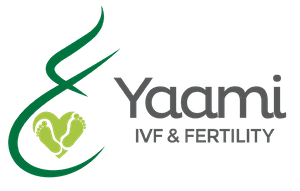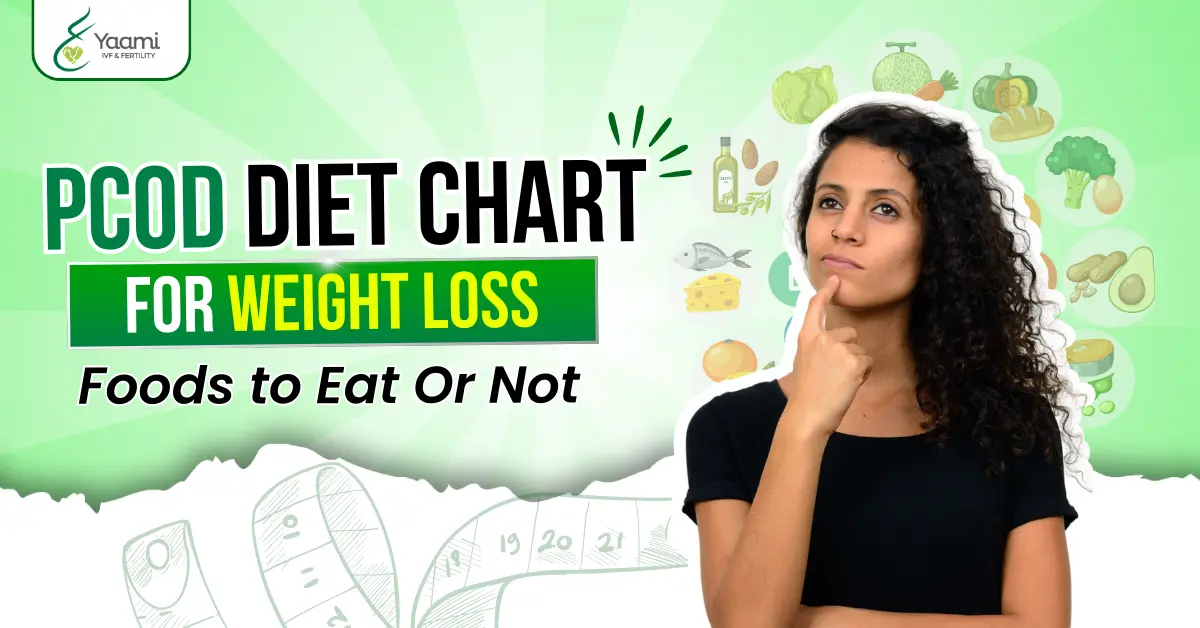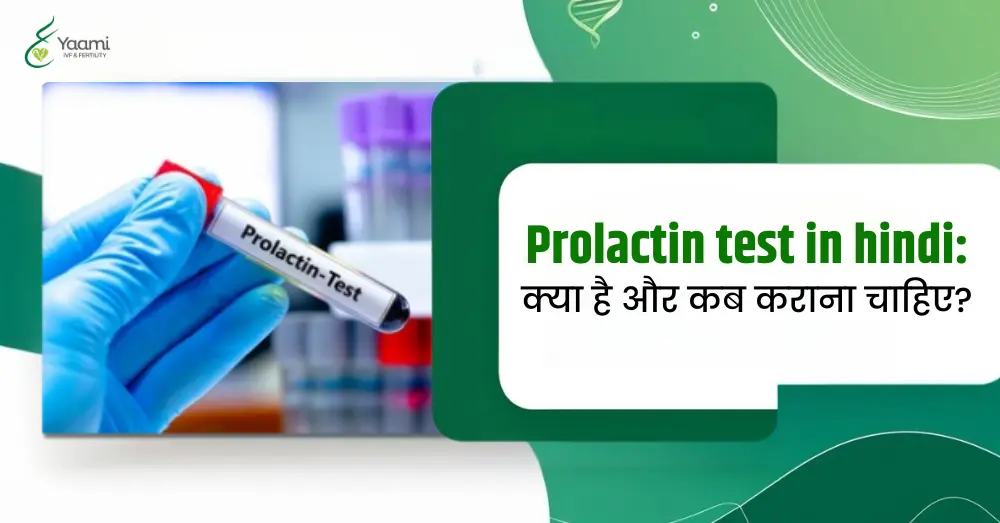Life with PCOD comes with a range of symptoms, including weight gain, hormonal changes, and energy fluctuations.
These changes can disrupt your everyday activities, making you dull and lethargic.
What you eat during PCOD plays a crucial role in influencing these symptoms, providing a powerful way to regain your health. Are you struggling with increased weight due to PCOD?
If yes, this blog, by Yaami IVF Center experts, will provide you with the complete PCOD diet chart for vegetarians and non-vegetarians.
In this, we have combined different options for lunch, dinner, and breakfast you can have to manage weight during PCOD. Let’s find out more about the options in the sections below.
PCOD Diet Chart for Weight Loss
1. Breakfast (8:00 – 9:00 AM)
- Oats Upma (1 bowl): Oats are high in beta-glucan, a soluble fiber that helps reduce insulin resistance and manage blood glucose levels. Adding a variety of vegetables increases the vitamin and mineral content, which is essential for overall health.
- Moong Dal Chilla (2 pieces): Moong dal is an excellent source of plant-based protein and dietary fiber, essential for hormone regulation and promoting satiety, which can prevent overeating.
- Mixed Vegetable Paratha (2 pieces): Whole wheat provides sustained energy release, while the fiber in the vegetables helps maintain digestive health. Cook it with minimal oil to keep it low in calories.
Non-Veg Breakfast Options (8:00 – 9:00 AM)
- Grilled Chicken Salami with Eggs (2 slices of salami, two eggs): This combination offers high-quality protein, which is crucial for repairing tissues and maintaining muscle mass. Cooking methods such as grilling reduce fat content.
- Fish Omelette (3 eggs, 50g fish): Fish like salmon and mackerel are rich in omega-3 fatty acids, which are known to reduce inflammation—a common symptom in PCOD.
2. Lunch (12:30 – 1:30 PM)
- Quinoa Biryani (1 bowl): Quinoa contains all nine essential amino acids, making it a complete protein source. It’s also high in magnesium and iron, supporting energy levels and overall metabolism.
- Chickpea Salad (1 bowl): Chickpeas are a low-glycemic-index food that helps manage blood sugar levels. When combined with vegetables, they add antioxidants that combat inflammation.
- Palak Paneer (1 bowl): Spinach is a rich source of iron, while paneer provides calcium. Both nutrients are vital for metabolic and bone health.
Non-Veg Lunch Options (12:30 – 1:30 PM)
- Grilled Fish with Sauteed Vegetables (150g fish, 1 cup vegetables): The lean protein in fish and the fiber from vegetables make this a heart-healthy option for weight management.
- Chicken Tikka Salad (150g chicken, one bowl salad): Chicken is a lean protein that helps build muscle, and raw vegetables provide enzymes and nutrients that support digestion and immunity.
3. Dinner (7:30 – 8:30 PM)
- Mixed Dal Tadka (1 bowl): Combining different types of lentils provides a synergistic effect, offering a wide range of essential nutrients like potassium, iron, and B vitamins.
- Stuffed Bell Peppers (2 medium peppers): Bell peppers are high in vitamin C, which helps absorb iron from the digestive tract, enhancing overall nutrient uptake.
Non-Veg Dinner Options (7:30 – 8:30 PM)
- Tandoori Chicken (200g): Marinated in spices and yogurt, it provides probiotics and proteins, aiding digestion and promoting gut health.
- Prawn Curry (150g prawns): Prawns are a good source of selenium, crucial for thyroid function and a healthy immune system.
5. Snacking Options (Between meals)
- Roasted Chana (1 small bowl): A great source of iron and protein, ideal for energy boosts without high calories.
- Cucumber Sticks with Hummus (1 cucumber, 50g hummus): The cucumber provides hydration and fiber, while the hummus offers a mix of protein and heart-healthy fats from tahini and olive oil.
6. Beverages (Throughout the day)
- Green Tea (2-3 cups/day): Contains catechins that help lose weight and improve insulin sensitivity.
- Buttermilk (1 glass): Provides probiotics for gut health and is a good source of vitamin B12, which is important for energy metabolism.
Read Also: PCOS क्यों होता है? कारण और बचाव के उपाय
Note: This diet chart is a general PCOD and weight loss guideline and may not suit everyone. We recommend consulting with a healthcare provider to tailor a diet plan to your needs, ensuring it is effective and nutritionally balanced.
PCOD Diet Chart: Foods to EAT
Protein Intake:
- How much: Aim for about 1.2 to 1.5 grams of protein per kilogram of body weight daily.
- What to eat: Include lean proteins like chicken, fish (especially fatty fish like mackerel and sardines), paneer (cottage cheese), lentils, and legumes. These foods help build muscle and regulate hormones.
Fibre-Rich Foods:
- How much: Target 25-30 grams of fibre each day.
- What to eat: Consume whole grains like oats, millets, and brown rice; vegetables like broccoli, carrots, and greens; and fruits like apples, pears, and berries.
Healthy Fats:
- How much: Approximately 20-35% of your daily calorie intake should come from fats, focusing on healthy sources.
- What to eat: Nuts, seeds, avocados, and oils like olive and coconut oil are excellent choices. These fats are crucial for hormonal balance and overall health.
Complex Carbohydrates:
- How much: Ensure that at least 50-60% of your carbohydrate intake comes from complex sources.
- What to eat: Include whole grains like quinoa and barley, as well as starchy vegetables such as sweet potatoes and pumpkin. These provide sustained energy and help maintain stable blood sugar levels.
Anti-inflammatory Foods:
- How much: Incorporate these into daily meals wherever possible.
- What to eat: Turmeric, ginger, tomatoes, and leafy greens can reduce inflammation associated with PCOD.
Low GI (Glycemic Index) Foods:
- How much: Focus on foods with a GI score lower than 55.
- What to eat: Legumes, lentils, and non-starchy vegetables help manage insulin levels and support weight management.
Read Also: PCOD Problem Symptoms in Hindi
PCOD Diet Chart: Foods to Avoid
Refined Carbohydrates:
- Why avoid: They can cause inflammation and worsen insulin resistance.
- What to avoid: Steer clear of sugary snacks and beverages, white bread, and pastries.
Excessive Animal Fats:
- Why avoid: High intake of saturated fats can worsen PCOD symptoms.
- What to avoid: Limit red meat and full-fat dairy products to reduce the risk of inflammation and help manage cholesterol levels.
Processed Foods:
- Why avoid: These often contain unhealthy fats and excessive salts or sugars.
- What to avoid: Avoid packaged snacks, fast food, and anything with artificial additives or preservatives.
High Sodium Foods:
- Why avoid: Excessive sodium can lead to bloating and water retention.
- What to avoid: Limit salty snacks, pickles, and processed meats typically high in sodium.
High Glycemic Foods:
- Why avoid: Foods with a high glycemic index can spike blood sugar levels and exacerbate insulin resistance.
- What to avoid: Reduce intake of white rice, instant noodles, and many breakfast cereals.
Conclusion:
Managing PCOD effectively involves a tailored dietary approach. Our comprehensive PCOD diet chart, created by IVF experts at Yaami IVF Center, provides a balanced mix of beneficial and harmful foods, promoting hormonal balance and overall health.
At Yaami IVF Center, we understand that each individual’s needs are unique. We offer personalized consultations and diet plans crafted specifically for your health goals. Contact us for expert guidance and support in your journey toward better health.
Let’s work together to tackle PCOD with informed dietary choices and professional care. Visit our website or contact us directly to schedule your consultation.
FrAQ: PCOD Diet Chart for Weight Loss
Q1. How to lose weight fast in PCOD?
Focus on a high-fiber, low-glycemic diet, incorporate regular exercise, and consult a dietitian to create a tailored meal plan that considers your needs.
Q2. Can I eat poha in PCOD?
Yes, poha (flattened rice) is a good option for PCOD as it’s a low-calorie, easily digestible carbohydrate that can be enhanced with vegetables for added fibre.
Q3. Which drink is best for PCOD?
Green tea is highly recommended as it contains antioxidants that help reduce inflammation and improve insulin resistance.
Q4. What to not eat in PCOD?
Avoid high-glycemic and processed foods, excessive dairy, and sugary beverages as they can exacerbate insulin resistance and inflammation.
Q5. Can we drink milk in PCOD?
Milk can be consumed in moderation; however, opt for non-fat or low-fat versions to avoid aggravating symptoms. Some people may prefer non-dairy alternatives like almond or soy milk, especially if they are sensitive to lactose.

Dr. Swati Singh (MBBS, MD – Obstetrics & Gynecology, DNB, FRM, Diploma in Reproductive Medicine and Embryology – Germany) is a leading Infertility Specialist and Gynecologist with over 18 years of experience. As Co-Founder and Senior Consultant at Yaami Fertility & IVF Center, Indore, she offers advanced fertility care including IUI, IVF, ICSI, and management of female reproductive disorders. Known for her compassionate and patient-first approach, Dr. Swati combines global training with deep clinical expertise. She is also actively involved in women’s health advocacy, medical research, and promoting awareness about reproductive wellness and fertility treatments.














